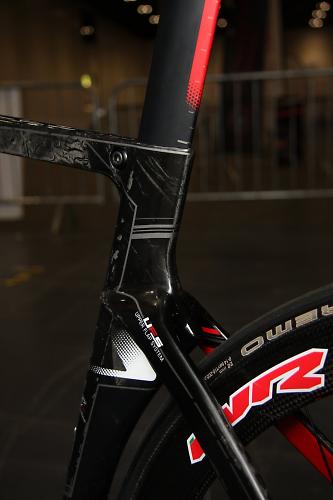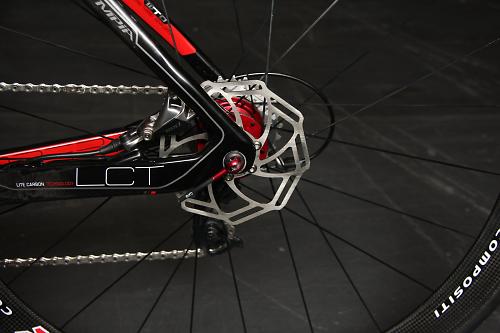- News
- Reviews
- Bikes
- Accessories
- Accessories - misc
- Computer mounts
- Bags
- Bar ends
- Bike bags & cases
- Bottle cages
- Bottles
- Cameras
- Car racks
- Child seats
- Computers
- Glasses
- GPS units
- Helmets
- Lights - front
- Lights - rear
- Lights - sets
- Locks
- Mirrors
- Mudguards
- Racks
- Pumps & CO2 inflators
- Puncture kits
- Reflectives
- Smart watches
- Stands and racks
- Trailers
- Clothing
- Components
- Bar tape & grips
- Bottom brackets
- Brake & gear cables
- Brake & STI levers
- Brake pads & spares
- Brakes
- Cassettes & freewheels
- Chains
- Chainsets & chainrings
- Derailleurs - front
- Derailleurs - rear
- Forks
- Gear levers & shifters
- Groupsets
- Handlebars & extensions
- Headsets
- Hubs
- Inner tubes
- Pedals
- Quick releases & skewers
- Saddles
- Seatposts
- Stems
- Wheels
- Tyres
- Health, fitness and nutrition
- Tools and workshop
- Miscellaneous
- Buyers Guides
- Features
- Forum
- Recommends
- Podcast
TECH NEWS
First look: Olympia Leader Disc
Disc brakes are sweeping through the cycle industry and the latest manufacturer to release a disc-equipped road bike is Olympia. This is their Leader, this first road bike designed specifically with disc brakes a key feature. We first brought you news of it last year but at the London Bike Show we had our first close look at the bike in the flesh.
The Leader not only represents the company’s first foray into disc brakes on road bikes, but also that of aerodynamics. Disc brakes and aerodynamics are the two biggest trends in road cycling at the moment, but they’re largely independent of each other, the Leader is one of a tiny handful of new bikes that pushes both aerodynamics and disc brakes.

The frame is clearly shape and profiled to cleanly slice through the air and reduce drag, which should help offset disc sceptics concerns of the increased drag caused by disc brakes. The main tubes use an airfoil profile with an aero seatpost held in place with a concealed clamp, while the seat tube wraps around the rear wheel. The seatstays meet the seat tube much lower than a regular frame, a trend we’re seeing with a lot of aero bikes. It’s all about reducing drag, and placing the stays low like this appears to be a popular way of contributing to the overall aerodynamic efficiency.
Olympia have designed the profile of the tubes and even the carbon fibre layup to accommodate the disc brakes and the location of the forces they place on a frame, using a mixture of T800s, T700 and M30 carbon. The rear brake caliper has been placed inside the rear triangle, a move we’re seeing most manufacturers adopt. The chainstays are oversized and asymmetric to help handle the forces created by heavy braking.

The fork has a lower crown height, because there’s no need for the caliper mount drilled through the crown, which has enabled Olympia to place the headset bearing lower and, so they claim, increase stiffness. The fork, like the chainstays, is asymmetric to deal with the disc brake forces. The head tube is tapered with 1 1/8in - 1 1/2in bearings.
Like most modern frames, the Leader is fully compatible with mechanical and electronic groupsets, with all cables internally routed. Showing that Olympia really have designed this bike for disc brakes, the hydraulic hoses are routed internally too. Clean lines abound.

While some manufacturers are dabbling with bolt-thru axles, a technology borrowed from the mountain bike industry, Olympia say the layup and design of the fork and rear triangle negates the need for bolt-thru axles.
The Leader is only being sold as complete bikes. It will be available with Sram Force Disc 22S with Vision Team 30 Disc wheels from £4,329.00, Sram Red Disc 22S with Vision Team 30 Disc wheels from £5,799.00 or a new special edition Ultegra Di2 Disc 22S with WHRX31 Disc wheels for £5,799.00.

Upgrade wheels are available from the factory, including Miche SWR full Carbon Tubular Disc wheels for an extra £9,29.00 or FSA Vision Metron 40 Carbon Clincher Disc wheels at an extra £1,191.00
The bike here has been built up by distributor Poshbikes, and features SRAM’s Red 22 hydraulic disc groupset with WR Compositi 43 mm carbon tubular rims laced to Tune Prince/Princess hubs using Sapim CX-Super spokes. These wheels, which weigh a claimed 1,084g for the pair and cost £2,000, shave 1lb off the complete build compared to the regularly specced Vision Team 30 Disc wheels.

To shed even more weight the stock Red rotors have been replaced with lightweight Tune rotors. The standard handlebar and stem has been replaced with an optional Olympia 'Raptor' carbon bar/stem combination.
More at http://poshbikes.com and www.olympiacicli.it/eng/
David worked on the road.cc tech team from 2012-2020. Previously he was editor of Bikemagic.com and before that staff writer at RCUK. He's a seasoned cyclist of all disciplines, from road to mountain biking, touring to cyclo-cross, he only wishes he had time to ride them all. He's mildly competitive, though he'll never admit it, and is a frequent road racer but is too lazy to do really well. He currently resides in the Cotswolds, and you can now find him over on his own YouTube channel David Arthur - Just Ride Bikes.
Latest Comments
- yellowjack 1 sec ago
Same sketch everywhere, or so it seems. Take Whitelegg Way in Bournemouth. Wide cycle lanes put in both sides of a (formerly very wide) two lane...
- yellowjack 16 min 40 sec ago
Sounds cool. I haven't taken an "unnecessary flight" since 1992. Flown many times since then for work, but you can't patrol the Iraqi desert, or...
- NOtotheEU 40 min 13 sec ago
My first thought on reading the headline was "ooh, has Clevedon put in covered bike parking now?".
- TheBillder 1 hour 36 min ago
I rented a car a few weeks ago, a Skoda Octavia (needed a big car for a weekend), and the ride was astonishingly good compared to my own 10 year...
- Sriracha 2 hours 33 min ago
Shimano were castigated for not bringing on new factories to meet pandemic demand, thus gumming up the supply chain. Their argument at the time was...
- Romanp 2 hours 43 min ago
I figured out a reason of that squeaking noise. I have xpresso 2 and 7, and also xpro 10 pedals, and that squeaking isn't present only at Xpresso 2...
- MichaelWinnerRIP 3 hours 44 min ago
Italian tourist and pussycat in Portugal.
- David9694 4 hours 31 min ago
Yep, it's official - reds under the, er, bonnet...






Add new comment
14 comments
Non-UCI and aero...Never heard of a tri bike with discs before, that's what its got to be right?
@ the Daves - are you testing these with just the ice tech rotors or standard non-finned types, centrelock / 6 bolt and so on?
Interested to see that the £6k Ultegra Di2 version of that bike comes with a pair of 2kg £200 wheels... something a bit awry with the spec there IMHO.
i wouldn't advocate the use of super lightweight rotors on the road after what happened to Tyler - that's a couple of years back now but the physics is the same: if the rotors can't store and dissipate heat faster than you're generating it, you're in for trouble. road tyres on tarmac generate more grip than mountain bike tyres off road, and speeds are faster, so there's the potential to generate a lot more heat.
Having said all that, i've been doing my best to cook the new Shimano system. I'm 100kg and there's plenty of long and steep descents to test them on. Nothing so far. Can't even get them to fade, really.
Looks like a two year old BMC with a pretty ropey paint and graphic job.
Sorry, call me a Luddite but discs are just ugly. I'm with the UCI on that one.
The UCI haven't disallowed them because they're not pretty.
They've missed a trick there then. I'll be writing to them
It's *very* pretty, but I'd have concerns about how well those rotors will dissipate heat (in hydraulic guise), especially at the rear.
I've used fancy lightweight rotors on my mountain bikes in the past and they've never been a problem, compared to regular rotors in any way, so I'd expect these lightweight Tune rotors to be just fine. Course, the only way to find out is to test them ourselves and that's something we'll try and do as soon as we can
Yes, but mountain bike braking and road bike braking are different beasts. On the MTB, I tend to be on and off the brakes regularly and the rotors are larger diameter (200mm/180mm on my bike, but likely to be 160mm at least). On the road bike on long descents, I'm much more likely to need to drag the brake, especially at the rear, and the speeds are commonly much higher - and, of course, the energy dissipated by the brake varies as the square of the speed.
I hear your concerns. That's why both Dave and I are currently testing bikes with Shimano's new hydraulic disc brakes, so we can find out how they perform in a variety of situations. So far, I'm nothing but impressed, even when dragging the brakes
I'd love a go on one of these.... once I'm skinny and fit again
^^ This
More of these kind of bikes please, don't care what the UCI thinks, this is what I want to buy! (just make 'em a bit cheaper, please )
)